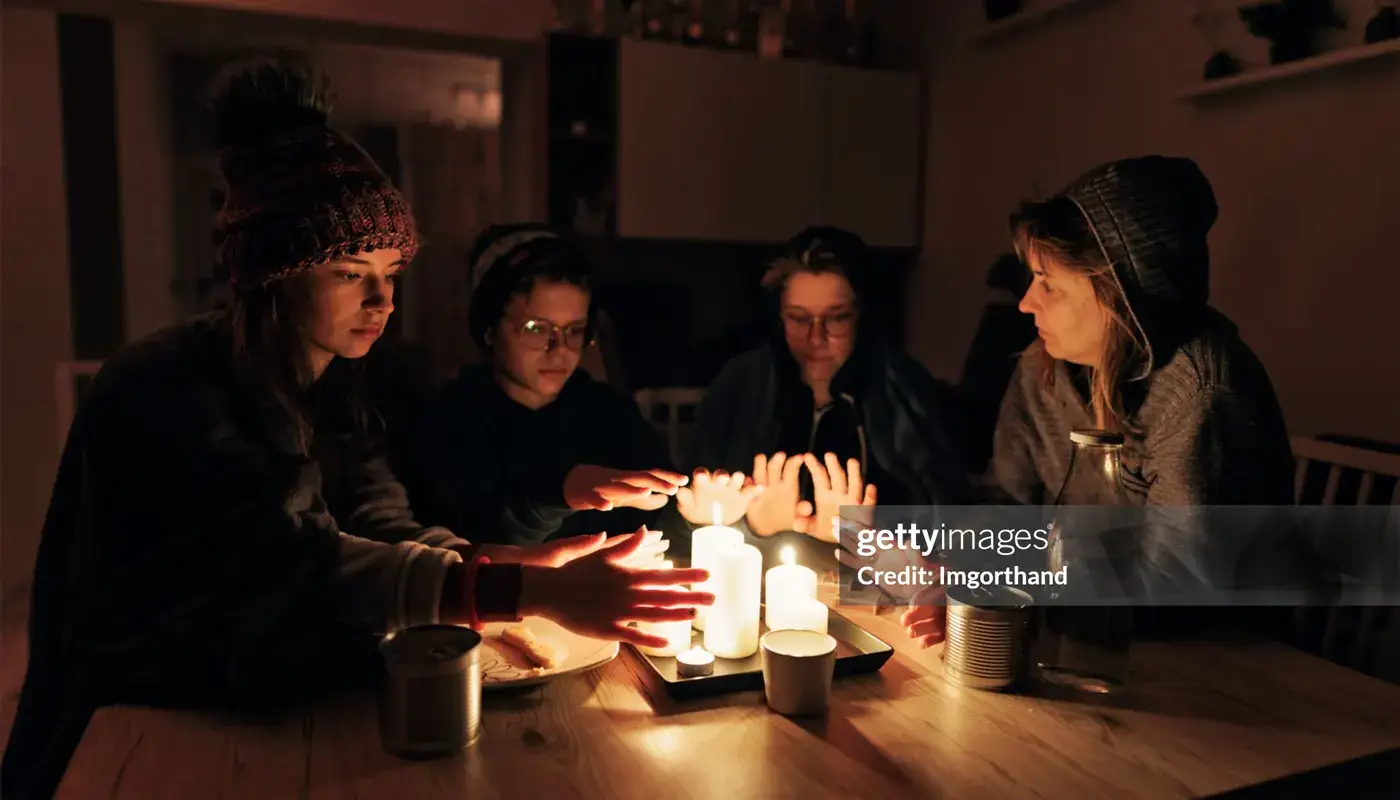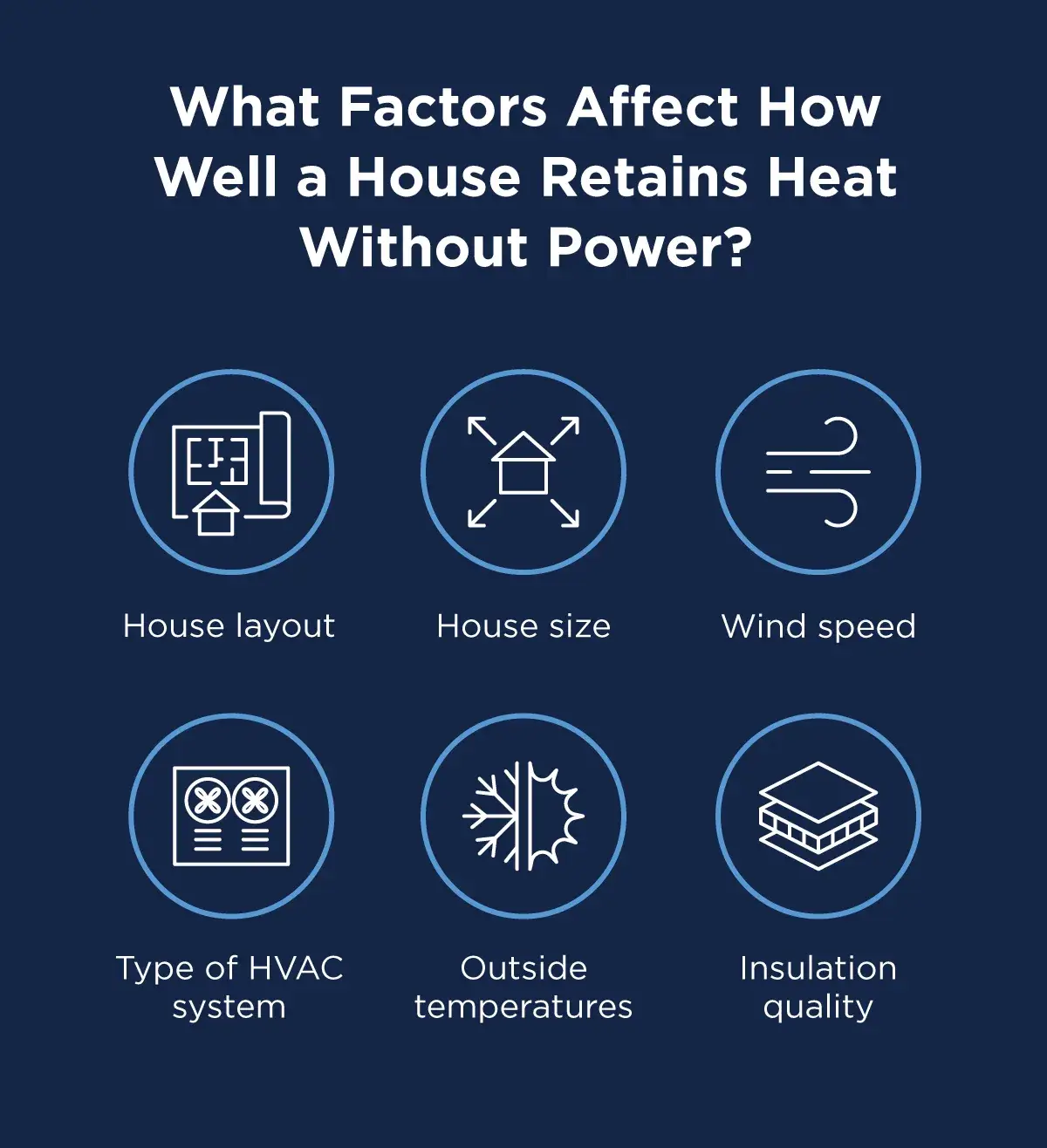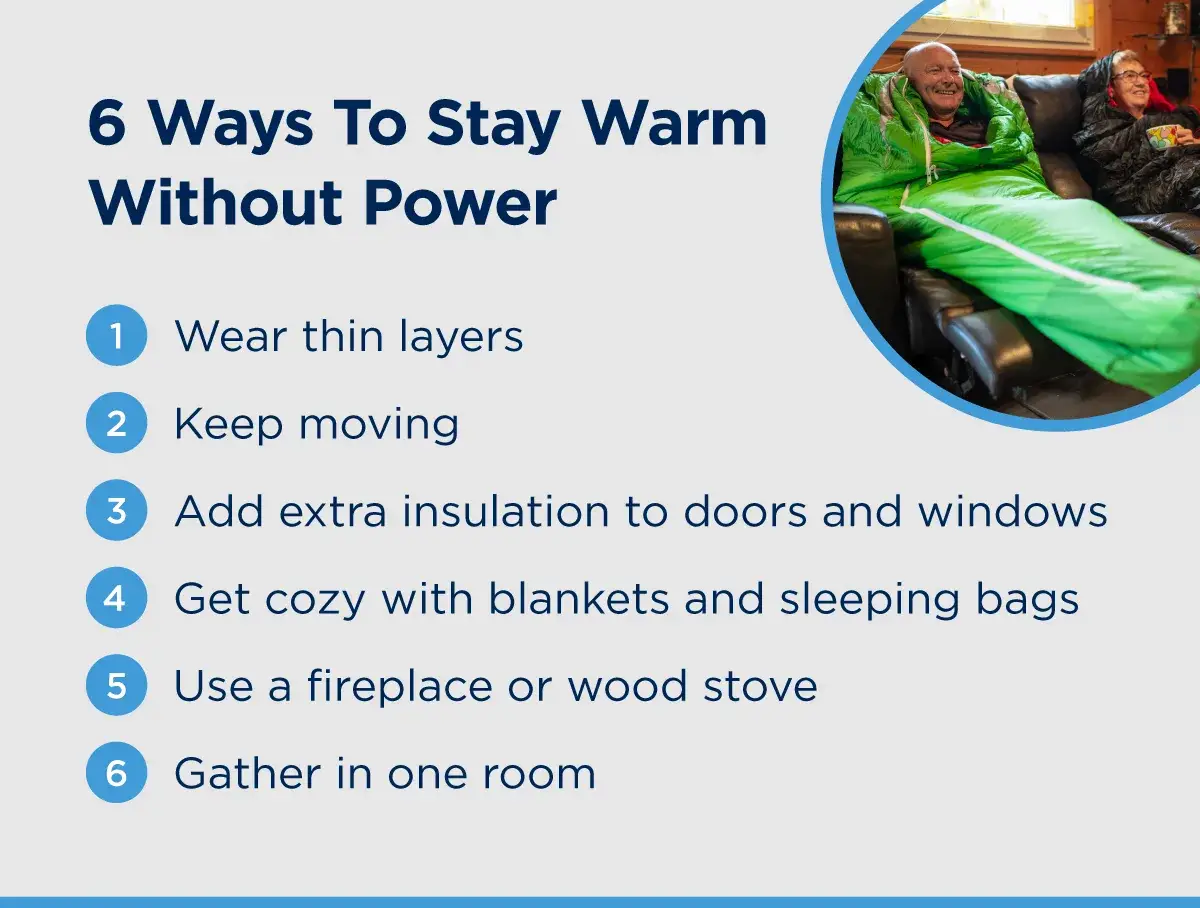How Long Will a House Stay Warm Without Power?

|
Quick answer: A house can stay warm for 8 to 12 hours after losing power, depending on weather conditions and insulation. After that point, inside temperatures will begin to drop. |
When the power goes out in the winter, the clock starts ticking. How long will a house stay warm without power? It’s a straightforward question, but the answer depends on several factors, such as house insulation and layout.
The average home will stay warm for 8 to 12 hours after the power goes out. After that, most homes will gradually cool over the next couple of days. Winter power outages present distinct challenges, such as how to keep warm without electricity.
The Aire Serv® professionals share practical preparation tips and knowledge to ensure your home remains a refuge of warmth during an outage. If your heating isn’t working as efficiently as it should, schedule furnace repair before a storm hits to prepare for the cold.

Factors that Affect How Long a House Will Stay Warm
As previously discussed, the average home retains heat for 8 to 12 hours. However, several factors will impact the amount of time your home can retain heat. Factors like the construction of your home and the external environment all need to be taken into account. Understanding these factors equips you to protect your family the next time your home loses. Here are the factors to consider when determining home long your home can stay stay warm during a winter power outage:
Type of heating system
Most types of heating systems don’t work when the electricity goes out. If you’re worried about losing power in the winter, install a combustion-based system, such as a wood-burning stove, as a backup option to help you stay warm.
Although geothermal and gas heaters don’t use electricity to generate heat, they won’t work without it. This is because electricity is needed to pump the heat throughout a home and regulate the temperature. The flame sensor that detects whether the pilot light is on runs on electricity, so if there’s no power, the heater will turn off.
Type of house and its construction
How long a house will stay warm without power is influenced by its construction. A brick house may retain heat longer than one made of wood, and a well-sealed, modern home with sufficient insulation will provide a few precious hours of additional warmth compared to an older, draftier one. To maximize heat retention, conduct regular HVAC maintenance like air duct sealing, which makes your heating system more efficient and prevents drafts when the system has no power.
Size of the house
The house's size and shape also impact how long the house will stay warm without power. A larger home has more opportunity to lose heat compared to a smaller home. Some home styles also have a larger exterior surface area, which can lead to more heat loss. For example, a detached, multi-story home loses heat more rapidly than a single-level condominium that is attached on both sides.
Insulation in the house
The insulation of your home significantly impacts how long it will stay warm without power. A well-insulated home retains heat far more effectively than a poorly insulated one. An insulation upgrade can improve energy efficiency in good weather conditions and better protect families during a winter power outage, and keep your home cooler during the summer.
Outside temperature
Of course, the outdoor temperature is an enormous factor in how quickly your home loses heat in a power outage. Extremely low temperatures outside can exponentially increase the rate of heat loss indoors. If you’re expecting cold weather or live in an area with extreme temperatures, winterize your home to boost heat efficiency and create safer conditions if power goes out.
Wind speed
High winds exploit any weaknesses in insulation or tiny gaps in a structure, bringing the freezing outside air inside. When the wind speed is higher, it quickly saps the warmth from your home.

How To Stay Warm Without Power
Homeowners can preserve their house temperature during a winter power outage with proactive home upgrades before the winter storm season begins. It’s also key to know how to conserve heat during an outage. The choices you make during an outage affect how long the house will stay warm without power.
Heat preservation isn’t solely determined by structural and external conditions. Everything from how you use available resources to small shifts in your daily activities can help you conserve heat the longer your home is without power.
1. Dress in layers
Conserving your body heat is the first step to keeping warm without electricity. Dressing in layers can help. Contrary to what you might think, there’s no need to pile on all your bulky sweaters. Multiple thinner layers, such as long-sleeved tee shirts, are more effective at preserving body heat. Plus, with multiple thin layers, it’s easier to add and remove warmth as needed. This keeps you from sweating, which may make you feel colder in the long term.
2. Use blankets and sleeping bags
A winter storm is the perfect opportunity to pull out some of your camping gear. Bundle up in blankets and sleeping bags that will trap warm air next to your body. Use them as portable, temporary personal insulation.
3. Stay active
Physical activity is essential to keep warm when the power is out. Your body generates heat when you move, creating natural warmth you can use when the power grid fails. Engage in light, consistent activities such as walking around the house, doing mild exercises, or even light housework to boost your internal heat. Just be sure to pace yourself. You don’t know how long the outage will last, and breaking a sweat could just make you colder.
4. Close and insulate doors and windows
In addition to closing the doors and windows to the outside, place towels around their perimeter to cut off drafts and boost insulation. Keep curtains shut to preserve more heat unless the window brings in warm sunlight during the day.
5. Stay in one room
A large residence can be an advantage in a power outage. Gathering your family members or friends and staying in a single room allows you to maximize your resources to insulate one space. Isolating activity to a single room also helps concentrate body heat, minimize the area that requires warming, and limit avenues for heat loss. Choose a smaller, well-insulated room if possible.
6. Use a fireplace or wood stove
If your home has a fireplace or wood stove, it can be an excellent heat source during a power outage. Have a supply of dry wood, kindling, newspaper, and matches or lighters in your emergency kit if the power goes out. All the standard safety concerns apply, so keep the flue clean and never leave the lit fireplace or stove unattended.
Power Outage Safety Tips
While figuring out how to stay warm without power is critical, there are a lot of common safety mistakes that can be far more dangerous than a winter power outage. Knowing what NOT to do in these situations can be just as important as knowing how to preserve heat:
- Only run generators outdoors: Generators produce carbon monoxide, a colorless, odorless gas that can quickly become lethal in enclosed spaces. Always use a generator outdoors, well away from windows and vents.
- Don’t use kitchen appliances for heat indoors: Your gas stove or oven is engineered to be a cooking appliance, not a continuous heating source. These heat sources are safe for the time it takes to cook a meal — not for extended periods. Overusing stoves and ovens increases the risk of carbon monoxide buildup and fire. Always ensure good ventilation and never use these appliances solely for heating.
- Don’t run your car inside your garage: The heater inside your vehicle may be tempting, but running the car in a garage is a fatal mistake. Breathing vehicle emissions can lead to carbon monoxide poisoning, and you typically won’t know until it’s too late.
- Don’t use portable stoves, heaters, or grills inside: Camp stoves, chimneys, gas-fired patio heaters, or charcoal grills produce heat, but they also release deadly carbon monoxide. Never operate a portable gas, charcoal, or wood-fired appliance indoors. These combustion appliances are only safe to use outside in the open air.
- Follow safety protocol for space heaters: If you have a generator and are using a space heater, always follow the manufacturer’s instructions. This includes plugging the heater directly into the power source (not an extension cord), keeping the area around the heater clear, turning off the heater when you exit the room, and other basic precautions.
- Don’t leave candles lit unattended: Always blow out candles when going to sleep or leaving a room. The risk of an accidental fire is too great.
- Ask for help when needed: Reach out to friends and family who live outside the power outage zone or contact emergency personnel to locate a safe shelter. This is especially important for households with young children, older adults, or those with health conditions.
Proactive Home Upgrades To Keep Your House Warm Without Electricity
While storms may cause power outages at any time, how you prepare for them is within your control. How long your house will stay warm without power can be positively impacted by a few pragmatic updates, including the following:
- Improve insulation with simple upgrades like new weather stripping to better retain heat.
- Install a whole-house generator to power essential heating systems.
- Improve ventilation to help regulate airflow and humidity.
- Install a backup battery or rooftop solar array to power your furnace or heater with your own electricity.
Stay Warm and Safe During the Next Power Outage
Winter storms can be unpredictable and intense. Knowing how to stay warm without power is critical for the safety of you and your family. If the power goes out, always follow the instructions of local officials.
To ensure your current heating system is operating at peak efficiency, contact your local Aire Serv professionals for help. Taking proactive steps now will better prepare your home for the winter, no matter what the weather throws at you. Aire Serv offers comprehensive professional HVAC services to keep your home comfortable, and the Neighborly Done Right Promise™ backs all our work, ensuring your satisfaction. Our experts are ready to assist with your HVAC needs throughout the year.
There’s no guarantee you won’t experience a power outage this winter, but you can make sure your HVAC system is ready, so request an appointment today.
This article is intended for general informational purposes only and may not be applicable to every situation. You are responsible for determining the proper course of action for your home and property. Aire Serv is not responsible for any damages that occur as a result of this blog content or your actions. For the most accurate guidance, contact the Aire Serv location nearest you for a comprehensive, on-site assessment.
FAQ About How Long a House Will Stay Warm Without Power
As a leader in the HVAC industry and a brand that is trusted by homeowners and businesses nationwide for our knowledge and experience, we’re happy to answer your HVAC questions. Here are answers to some of the frequently asked questions about how long a house will stay warm without power.
How long will a house stay warm if the power goes out?
After the power goes out, a house can stay warm for up to 12 hours. After that, most homes will slowly lose heat unless you have supplemental heating sources, such as a wood-burning stove or fireplace.
How long can a house go without heat before pipes freeze?
It takes around six hours for pipes to freeze without heat. If the pipes are well insulated, they can last longer without freezing.
How warm will a house stay without heat?
Generally, a house will stay warm for 8–12 hours after losing heat. However, without intervention, it will eventually reach outdoor temperatures. If temperatures are frigid outside, maximize the warmth by gathering the family in a small room, wearing many thin layers, and placing towels around windows and doors.
How fast does the temperature drop in a house without heat?
After around 8 to 12 hours without heat, a house’s temperature will drop by a few degrees Fahrenheit per hour.
How can you stay warm without electricity or gas?
If there’s no electricity or gas, you can stay warm with blankets and sleeping bags. You should stay in a small, well-insulated room with other people to help retain body heat. Find air leaks and place towels around them to reduce heat loss.
 Click to call
Click to call


